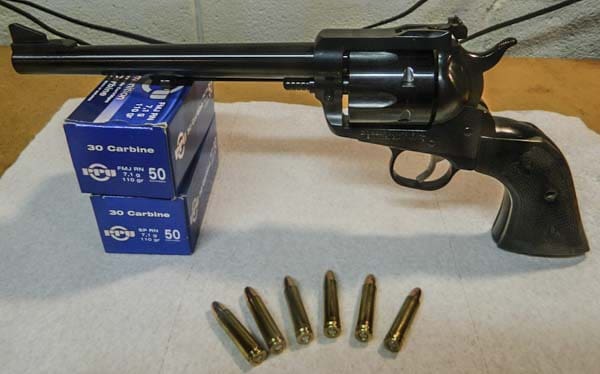
(This is a reader-submitted review as part of our gun review contest. See details here.)
By David Lockman
The idea of chambering a rifle cartridge in a handgun is a hardly a new one; although, in more modern days, some companies have taken the concept to the point of borderline absurdity. See chamberings such as .30-30 Winchester and .45-70 in the Magnum Research BFR, or… pretty much anything you can dream of short of a .50 BMG (limited only by one’s desire to maintain the structural integrity of their wrists) in a Thompson/Center Encore. And I’m not even counting the 600 Nitro Express Pfeifer Zeliska — if it weighs 13 pounds, it’s no longer a “hand”-gun.
The diminutive .30 Carbine, by comparison, is a rather more reasonable chambering for a pistol—if, perhaps, one of questionable utility. But some people just like to have something a little different, and the Ruger .30 Carbine Blackhawk certainly is that, and a boatload of fun besides.
The Ruger Blackhawk, first introduced in 1955, is, in essence, just a modernized and improved version of Colt’s classic and revered 1873 “Peacemaker” single-action revolver. Even in its early days, the Peacemaker was no stranger to rifle cartridges. In 1877, a mere four years after its introduction, Colt released a “Frontier” model of the pistol, chambered—rather than Colt’s (then-) proprietary .45 Colt cartridge — for the .44-40 round used by the similarly-popular Winchester 1873 lever-action rifle — allowing one to use the same ammo in both rifle and pistol. Very convenient. And the experiment seemed to work out for Colt, as they went on to release versions of the Peacemaker in both the .38-40 and .32-20 Winchester rifle cartridges as well.
Jump ahead 90 years or so, and Ruger took a similar route, releasing the .30 Carbine-chambered version of the Blackhawk in 1968, likely to capitalize on the wide availability of milsurp M1 Carbines and their ammo at the time. It was the first real commercial .30 Carbine handgun. (Technically, Kimball beat them to it by over a decade, having created a delayed-blowback semi-auto .30 Carbine pistol back in 1955. However, said pistol had more problems than the initial run of Remington R51s, and the company made less than 300 of them before folding).
Since then, others (AMT’s Automag III, Taurus’ brief flirtation with the Raging Thirty) have come and gone, while the .30 Carbine Blackhawk is still available today.
The Gun
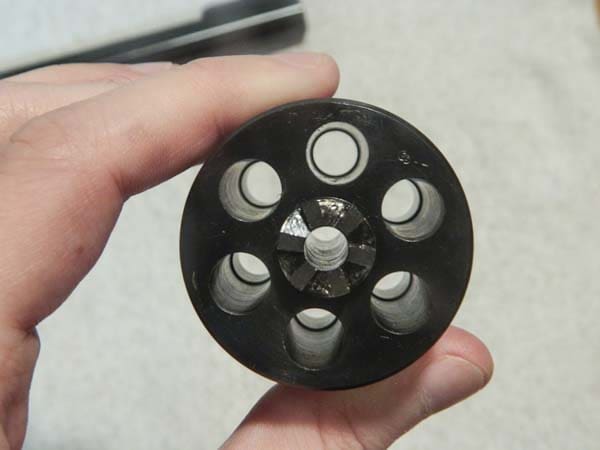
With a 7.5-inch barrel, and a 13.38-inch overall length, the .30 Carbine Blackhawk is a big pistol. Heavy, too; while it has a tapered barrel (one of the easiest ways to distinguish it from any other model of the Blackhawk) to save weight due to the small .30-caliber bore, the cylinder received no such treatment. It’s the same size as one for a .45 Colt Blackhawk, just with teeny tiny .30 Carbine-sized holes, so it’s quite a heavy chunk of steel.
Despite .30 Carbine being a moderately high-pressure cartridge, I suspect that the cylinder of the .30 Carbine Blackhawk might be one of the most overbuilt of any production revolver. In consequence, the pistol weighs in at a somewhat boat-anchor-ish 46 ounces.
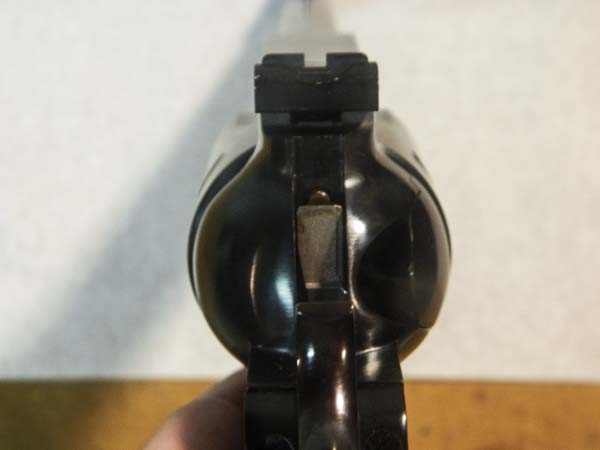
Mine is a “New Model” Blackhawk, meaning it uses a transfer-bar mechanism to prevent the hammer from striking the firing pin unless it has been cocked and the trigger pulled — allowing you to safely carry a full complement of six rounds in the cylinder, as opposed to having to leave an empty chamber under the hammer as with the original Colt and the older pre-1973 Blackhawks.
It also has a built-in locking mechanism, not unlike current Smith & Wessons (although, unlike S&W, Ruger was nice enough to hide the lock inside the grip, so it doesn’t detract from the gun’s aesthetics). While the lock makes about as much sense as a gallium frying pan, and I’d rather not have it — I’ve never touched it, and I don’t ever intend to — so far I’ve had no problems with it, so it’s not too much of a demerit.


The gun’s sights consist of a black ramp front, and a black square notch rear — nothing fancy, but they work well enough. The rear sight is click-adjustable for both elevation and windage (1 click = 3/4” @ 25 yards) with the aid of a small screwdriver. Mine came sighted in for a six-o’clock hold, and I’ve left it that way.
The trigger pull is short, crisp, and light — just as one would expect from a single-action revolver.
Ergonomics
When I bought this gun, I was a newbie to the Colt Single Action-style grip. However, once I figured out how to properly hold the pistol (I sort of let the gun “hang forwards” in my hand) I found that, despite its length and weight, the Blackhawk feels very balanced and good in the hand, and points quite well.
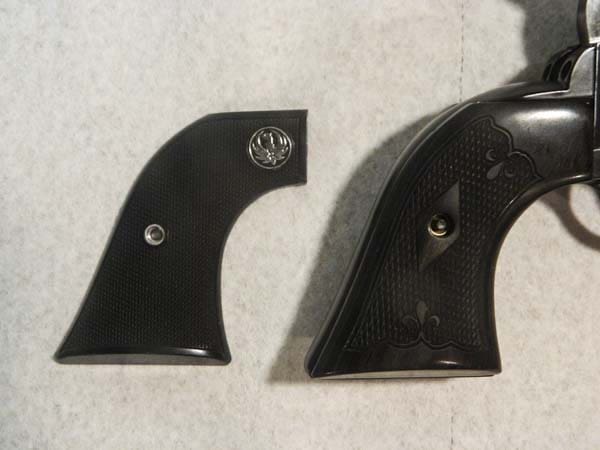
The pistol came with a set of black plastic grips featuring light checkering and the silver Ruger emblem (above left). There was nothing wrong with them per se, but I have rather large hands, and the original grips were too thin for my taste. So, after a bit of searching, I decided to replace them with a set of grips (above, right) from Altamont Co. (which, incidentally, makes some of the “factory” grips that come with some of the other versions of Ruger’s Blackhawk/Super Blackhawk pistols) in “Silver Black.” These grips swapped right on with ease, and, in addition to adding an extra bit of class to the gun’s appearance, are much thicker than the factory plastic ones, and fit my hand much better. At only $40 or so, I highly recommend them.
Fit & Finish
There is an inherent degree of sexiness and class in the Colt “Peacemaker” design, and the Blackhawk is no exception, despite being a little bigger and beefier than the original Colts to allow for the chambering of more powerful rounds.
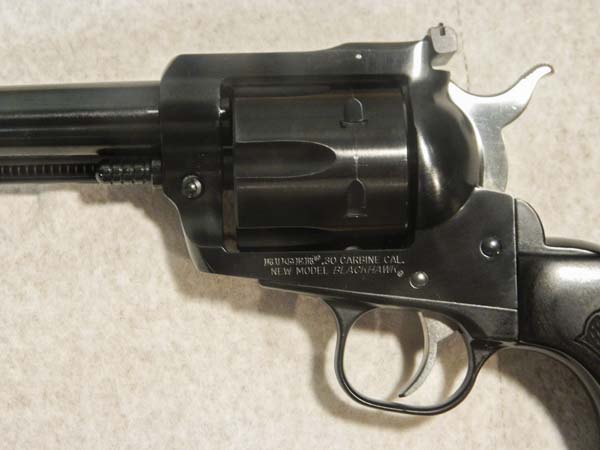
The entire gun, save for the grip frame and ejector rod housing, is made of steel, with a deep blued finish that looks almost black. The hammer, interestingly enough, is only blued on the top — the sides are left as bare shiny steel — and the trigger is also unblued. The grip frame and ejector rod housing are made of aluminum, given a black anodized finish so they more-or-less blend in with the rest of the gun; it works from a distance, but up close the difference is obvious, as the aluminum parts have a much duller sheen than the blued steel ones.
The finish seems to be of moderate durability; after several hundred rounds through the gun there are some slight scuff-marks on the cylinder — an inevitable occurrence with any revolver, I understand — and I somehow ( I seriously don’t know how) managed to put a little scratch in the finish on the underside of the barrel. The finish is, I would say, perfectly adequate; it looks nice — but nothing to write home about — and seems to be at least moderately durable.
The Blackhawk is a solid, quality pistol, and fit is, in general, excellent — with one notable exception; two of the chambers in my Blackhawk’s cylinder seem to be slightly tighter than the others, as they start sticking earlier — and become stickier — than the others. But, more on stickiness in a bit…
Disassembly
Disassembling the Blackhawk for cleaning couldn’t be easier. It goes like this:
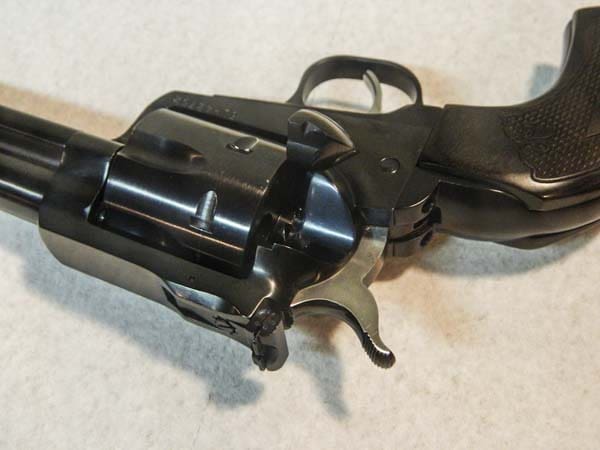
Open the loading gate.
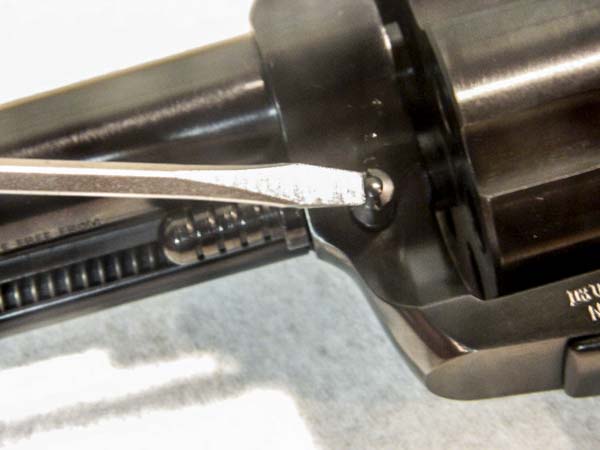
Depress the cylinder pin catch.
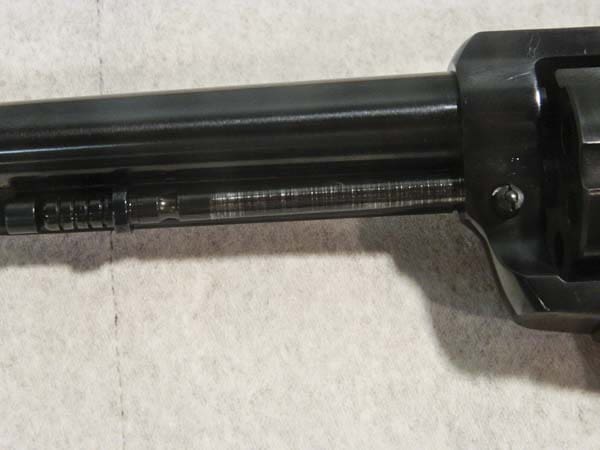
Slide the cylinder pin out.

Dump the cylinder out the right side of the gun.
And you’re ready. To reassemble, simply reverse the process.
The gun is very easy to clean — and a good thing too, as it needs to be cleaned rather often. But, more on that a bit later…
On the Range
While the .30 Carbine is considered rather light for a rifle round, compared to most pistol cartridges it’s hardly a slouch, tossing a 110-grain bullet at 1990 fps. or so, generating about 970 foot-pounds of energy — on par with the .44 magnum; however, that’s from the M1 carbine’s 18-inch barrel. So, how does it do in a handgun? The answer: Pretty well.
Now, the first thing you’re likely to notice when firing the .30 Carbine Blackhawk for the first time is that it’s rather loud. Not as loud, however, as most people on the internet would have you think; based on the various reviews and forum discussions of this gun that I read before buying it, I half expected the muzzle blast to shatter every piece of glass, and set off every car alarm, within a quarter mile radius or so. Long story short: it didn’t. In my opinion, it’s not even especially loud — I’d compare it to a 3-inch barreled .357 magnum that I once fired; I’ve heard 9mms that sounded almost as loud. I only wear simple foam ear muffs when shooting, and I’m perfectly comfortable (if you were to shoot it at an indoor range, then, yeah, you might want to double up on the hearing protection as a lot of people recommend for this gun).
The second thing you might notice, is that recoil is — well, not nonexistent, but, shall we say, practically unfelt. The gun certainly moves — there’s a modest bit of muzzle flip (as a result, I suspect, of the Colt Single-Action style grip, which tends to encourage the gun to “roll upwards” in your hand under recoil) — but the forces transferred to your hand are so light that you hardly feel it. It is, by far, the most pleasantly recoiling gun I’ve ever fired that wasn’t a .22. As to the round’s ballistic performance…
Fired from the Blackhawk’s 7.5-inch barrel, the .30 Carbine round loses several hundred feet per second of muzzle velocity (and hence quite a bit of energy) compared to when it’s fired from the Carbine — as one might expect when one more-than-halves the barrel length. One of my early reloads (a 110-grain Hornady FMJ over 13.7 grains of IMR 4227 — a very light load) chronoed an average of 1706 fps. from the carbine, and only 1239 fps from the Blackhawk, giving an average velocity drop of 467 fps. I haven’t had the chance to chrono factory ammo out of both guns (I don’t have many opportunities to use the chronograph), but from what I’ve read from other sources, the velocity drop is about the same, which would put factory 110-grain ammo in the 1400-1500 fps range from the Blackhawk.
Admittedly, those ballistics don’t sound too thrilling on paper, but let’s compare, shall we? My (quite light) reload above generated an average of about 375 ft-lbs. of muzzle energy; that’s similar to a standard-pressure 9mm — not especially powerful, but again, it was a light starting load. The estimated velocities for full-power factory ammo, on the other hand, give a potential muzzle energy range of about 479-550 ft.-lbs., on par with a .40 S&W — albeit with a much smaller, lighter bullet; or, for a better comparison, that puts it on par, energy-wise, with the Russian 7.62x25mm Tokarev cartridge, except with a slightly heavier bullet — and few people have ever complained about the Tokarev round’s performance (penetration-wise, at least). And, one could always crank up the velocities by going to a lighter bullet (like Hornady’s 90-grain XTP) if they so wished. Besides, what’s the saying — ”It’s better to hit with a .22 than miss with a .45?” Which brings us to the third major quality of this gun…
It’s pretty damn accurate. I am, admittedly, not exactly a stellar shot, but I shoot the .30 carbine Blackhawk better than any other pistol I’ve ever fired — which list includes a SIG, and a pair of nice Smith & Wessons.
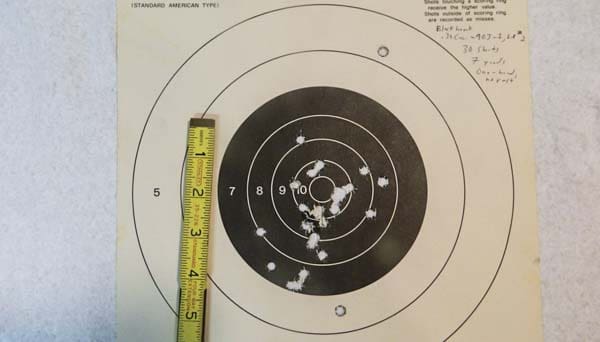
Here’s 30 rounds (another of my early handholds—a 90-grain XTP over 14.0 grains of IMR 4227) fired one-handed, no rest, at 7 yards.
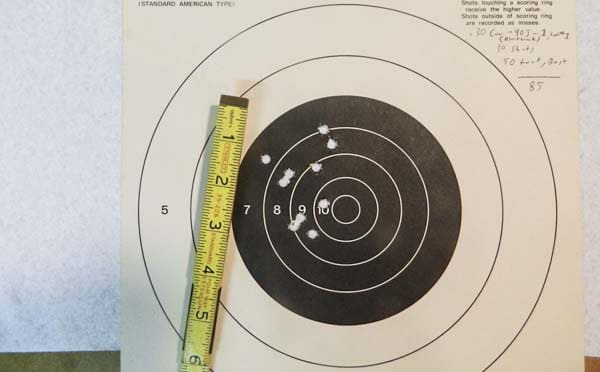
This is 10 rounds of the same load fired two-handed from a rest, at 50 feet.
Reliability
That revolvers are — if not perfectly reliable, then the closest possible thing — is widely considered to be axiomatic. I’m sad to say, but the .30 Carbine Ruger Blackhawk does not quite live up to this golden standard.
Previously in this review I alluded to stickiness issues, and a need for frequent cleaning; the .30 Carbine Blackhawk, I have discovered, is very sensitive to grime in the chambers of the cylinder. When the cylinder is clean, rounds drop all the way into the chambers with zero effort — as it should be. However, after firing a moderate number of rounds through the gun — usually around 60 or so — the chambers tend to start getting sticky, requiring fresh rounds to be seated firmly with finger pressure to make sure they go all the way in — lest they rub against the breechface and bind up the action somewhat.
This is, I am fairly certain, simply a consequence of chambering a rimless cartridge in a revolver (without the use of moon clips, which cannot be used with a fixed-cylinder revolver like the Blackhawk). Lacking the rim that every cartridge designed for use in a revolver has, the .30 Carbine headspaces, as normal, off the case mouth, which rests on a slight ledge towards the front of the chambers. When fired, the case sets back slightly in the chamber (as there is a slight gap between the rear of the case and the breechface of the gun), allowing some of the powder residue to be deposited on this ledge. Over repeated firings, this gunk builds up until a new round can’t be fully seated without compressing or pushing it out of the way.
At around the same time, extraction can also start becoming a bit difficult; I have had, on occasion, some empty cases which required a fair bit of force on the ejector rod to remove — although, I’ve never had to use anything beyond hand-strength. This occurs mostly with factory ammunition — my current handloads (which are loaded somewhat lighter than factory ammo, and hence are probably lower-pressure) almost never have difficulties with extraction, though the stickiness on loading is still an issue.
This is an easily solvable problem: just keep the chambers clean — I clean mine very often, and have found that simply running a dry bore brush through the chambers a few times can go a long way towards loosening them back up between real cleanings. However, 60 rounds or so is a rather small number before a gun starts having reliability issues, so it is a notable — really, the only — black mark against the pistol.
Conclusion
I love this gun. However, I have to admit that it’s somewhat like a circular pencil: Without an obvious point. There are certainly plenty of things it could be used for: Target shooting/plinking (though .30 Carbine is a bit expensive for a plinker), hunting varmints, even self-defense if you really wanted to for some reason and loaded the gun with a good softpoint or hollowpoint round. But, in all honesty, the same gun chambered in .357 Magnum could probably do all those things just as well (albeit, probably with somewhat more recoil when firing .357s), with rather more commonly available ammo that gives better handgun performance.
Really, the only thing the .30 Carbine Blackhawk can do that pretty much no other currently-produced handgun can is share ammo with an M1 Carbine. So, if you have your heart set on the little carbine as your SHTF/TEOTWAWKI rifle, and you really want a pistol using the same round as a backup, Ruger’s got you covered. Otherwise…
The Blackhawk 30 Carbine, from my experience, is a damn fine revolver. But whether to get one in .30 Carbine, or not, is entirely up to personal taste. It might not be the most practical pistol, but the .30 Carbine version of the Blackhawk is a well-made, dead-accurate, soft-shooting, all-around fun, and slightly unique firearm. For some people (like myself), that’s enough.
Specifications: Ruger New Model Blackhawk, .30 Carbine
Caliber: .30 Carbine
Action: Single-Action Revolver
Cylinder Capacity: 6 rounds
Materials: Alloy Steel, Anodized Aluminum
Finish: Blued, Black-Anodized
Weight Empty: 46 ounces
Barrel Length: 7.50 inches
Overall Length: 13.38 inches
Sights: Adjustable sights (Front ramp, adjustable rear sight)
MSRP: $669
Ratings (out of five stars):
Accuracy: * * * * *
It’s a hell of a lot more accurate than I am, and it makes me better by association.
Ergonomics (Handling): * * * *
On the heavy side, but it feels good in the hand and points well. The factory grips are rather thin, but that’s easily rectified.
Ergonomics (Firing): * * * * *
The trigger is great, and the recoil could hardly be more comfortable.
Reliability: * * * *
Not up to the golden standard of most revolvers. However, as long as the chambers are kept clean, reliability is essentially flawless.
Customize This: * * *
There is a fair variety of aftermarket parts for the Ruger Blackhawk, but a holster, and maybe a different grip, is probably all you’ll ever want or need.
Overall: * * * *
A handgun chambered in .30 Carbine probably isn’t for everyone. But if you like the idea of an accurate, quality pistol firing the Carbine round, the Ruger Blackhawk is an excellent choice.
More from The Truth About Guns:
How it Works: Single-Action vs. Double-Action




Yo, Dan! Think something is screwed up, here?
I don’t agree with your take on reliability. The weapon never malfunctioned, broke or otherwise acted up. It was a cleaning issue. All guns get dirty and all will cease to function at 100% when dirty. Every gun has its own limits on how well it functions dirty.
I think his quibble has to do with the number of shots between cleanings. From the review, it does seem to need them a bit more frequently than other revolvers I’ve had opportunities to own or shoot.
As he mentioned, if you shoot a straight walled cartridge meant for a revolver and it would be more reliable, like a .357. You can hot rod the crap out of .357 in a Blackhawk if you load your own. Even the published loads are clocking pretty fast, though the Hodgdon ones were tested in a 10″ barrel. Plenty of people use rifle primers (harder primer cups) and exceed recommended powder charges in their Blackhawks. It might not necessarily be smart, but the actions have demonstrated that they can handle those pressures.
I own one of these 30s, great shooter. The rounds did stick in the cylinder when new, I sent it back to Ruger and it came back with polished bores and never stuck again. It is loud, and has a good concussion. We took it to a local indoor range and when fired, the lens from the ceiling florescent light fixture fell from the fixture and hit my wife on the head. No damage to her, but we were told not to bring that gun back in there.
Whoa, I think this one needs to be formatted still. 😀
When it comes to .30 Carbine in a handgun, I’d kind of like an AMT AutoMag.
The 30 Carbine Blackhawk is the second loudest gun I ever fired.
The first is a Smith and Wesson 22Jet Model 53.
I put plugs in under my muffs to shoot either.
I’ll stick with the quieter 357 magnum.
Make it in .300 Blackout and you’ll sell a pile of them!
If it were a Taurus then there would be four things I don’t want about loud 30 carbine old-school revolver.
But seriously, great review. The level of detail and history makes for good reading regardless of how lame the firearm is in real life.
Regardless of the merits or failings of the gun this is a great review. I especially like the sight picture photos & the cleaning sequence of any firearm is a important consideration. Thanks!
I really, really want to like the idea of a 30 Carbine gun. I wish they’d have made this a 7 or 8 shooter and done some work to try and lighten the cylinder through additional machining or different materials (aluminum/steel hybrid.) Going from memory a Desert Eagle comes in at a few oz lighter than this tank.
Ultimately my question becomes what would this stack up against in terms of say a light .357 Magnum bullet (my Lee 105 SWCs that are powder coated specifically in my mind.) Such a gun would have a great deal more versatility in the long run not to mention ammunition availability.
What I’d be curious about is how this fared against other options in terms of mid range ballistics just because the bullet profiles are going to be better than say a SWC.
That said supposedly people shoot 32-20s from these as well? Just an interesting note of Internet lore I figured may be relevant. Perhaps some Hi-Vel rifle only stuff since this would likely take the pressure. Not sure what it’d do for barrel life though.
The 32-20 is a bottle neck rimmed case using a .312 dia bullet so what happens to the case when its fired in a 30 carbine rimless cylinder?I stuck a 32-20 in my 30 carbine blackhawk and the rim stops it from going in far enough to close the loading gate let alone spin the cylinder.Now if you had a 32-20 cylinder made for the 30 cal.blackhawk that would be a very interesting conversion.The cylinder on the 30 carbine is the same length as the 44mag super blackhawk so the length would be no problem.
Nice, detailed article. While the gun is not my cup-o-tea, I never write off an oddball. Just because there appears to be no practical, real world application in a gun, doesn’t necessarily mean it should be discounted. Sometime “just because” is good enough.
I knew nothing about this particular Ruger, and now I do.
Thanks for the review!
.30 Carbine in a revolver does nothing better than what the .327 can and the .327 can shoot 3 to 4 other cartridges.
If you absolutely have to have a .30 Carbine rifle and want sidearms chambered for same ammo, go for it, but otherwise the .30 Carbine is soon to join obsolete centerfire cartridges.
Say someone with out much clue.
So how long has the 30 Carbine been around and in use? That’s right a lot longer that you have been around. Until you mentioned it I’ve never heard of a 327, had to go look it up.
Might have been a great round but the dust bin of history is the 327 not the still in production 30 Carb!
Time to smell the roses. The 30 Carbine has its place. Granted its not the end all round some other are but for it’s purpose in WW2 it served quite well.
What I would like to see is an AR chmbered in 30 cal Carbine. Far more practical than a single action revolver.
I enjoyed reading this review. I would have liked to see a picture that showed the taper of the barrel more clearly.
With regard to the issue of sticking cases: while the author posits a plausible explanation, I wonder if he also considered the possibility that his light handloads were too light to properly expand the brass upon firing, thus allowing more crunk to blow into the chambers than a full powered round would. One way to check this might be to anneal the brass cases before loading to soften them and see if chamber sealing was improved, perhaps reducing or eliminating the sticking problem.
I think you may have hit on something here. Excellent point.
Probably more likely with rifle brass, which is thicker than pistol brass.
Actually this is a common problem. I have it as well. The bore as someone else mentioned needs to be polished a bit better from the factory. I have one in particular that will stick after the first shot. IF I spray it with some lub before firing. I can shoot 2-3 round before time to spray some more for 2 of the chambers in the cylinder.
Haven’t gotten around to sending back to Ruger to fix. But this is a known issue.
Not an expert, but 4227 seems a bit slow, wouldn’t something like VV 3N38 be a more appropriate powder for a 7.5″ barrel. It fills the case and burns almost completely in that 7.5″ according to QL. Looks like a big velocity gain too.
By “not an expert” I mean, among other things, that I never loaded a .30 carbine before or used 3N38 for anything. So I apologize if this way off base.
Nice interesting review. So who’s better? This or the BFR?
“In consequence, the pistol weighs in at a somewhat boat-anchor-ish 46 ounces.”
This kind of comment always makes me laugh. One can really see the effect of polymer and sub-compact design on POTG thinking/expectations.
My EDC semi is 42 ounces, and it’s not the only full frame steel pistol in that weight class.
Yeah, 46 > 42, but is it really THAT much to get into ‘boat anchor’ territory?
I really like the 30 carbine cartridge. I miss the days of cheap surplus. They are too expensive these days.
Where the .30 Carbine Blackhawk shines is when you start tailoring handloads for it rather than using ones tailored for an M1 Carbine. You can get some impressive results out of it because of the strength of the gun.
Buffalo Bore is making some .30 stuff at around 2200 fps, rifle. I want a .223 revolver! LMAO
Thanks for a very useful review. Never owned a Blackhawk in 30 Carbine, but I can tell you the 357s aren’t much lighter. Like wearing a bucket of sucker rod on your hip. For sweetness and light, however, the 45 Colt version can’t be beat. Anything with nearly 1/2 inch holes running through it lets in lots of fresh air.
Gallium frying pan. Nice.
Good idea when 30 carbine surplus was 50 cents a box of 50. not so much anymore.
I inherited quite a few guns from my father including a sw 357, 30 cal Blackhawk and an m1 30. I absolutely love the Blackhawk. It does have sticking problems as stated but it’s not that big of a problem. I enjoy shooting it more than my 357 and have never had problems finding ammo.
For a fun plinking or water jug exploding experience, try reloading with 40- or 55-grain .224 bullets in sabots. No recoil at all, but whopping muzzle velocities in the 2500 f/s range using 12 grains of H110. Flat-shooting popgun that – in this gun, with its beefy cylinders, could probably be loaded up to near-3000 f/s with the 40 grain bullets without issue. Don’t get me wrong – it’s not a long-range shooter; the 1:20 twist won’t stabilize well. But for a blast (pun intended) at short range, it’s worth a try.
My father bought a .30 carbine Blackhawk in 1981 . I’ll never forget that year. Dad , was a Police-Officer , and he never used or believed in using “Hearing Protection” , and consequently either did I . I was 18yrs/old at the time , and had probably fired a hundred thousand rounds by that age . Well , to say that the .30 carbine Blackhawk is loud , is an understatement . I lost all hearing in my right ear after 6 shots , and never regained-it !
I have an AMT Automag III in 30 carbine – I shoot it every 4 or 5 years and we never accurate from the bench using SP 110gr or fmc/fmj 110gr. Today I measured the twist rate and found out it is 1:16 from a 6 5/8 barrel? I was curious what the black hawk 30 carbine twist rate is – I never fired it closer than 25 yards and I am wondering if it has stabilizing issues because of the short barrel, slower twist rate and fairly heavy bullet weight?
There is a formula somewhere (on every AR forum) to calculate rpm of the bullet based upon twist rate and fps I believe? Does anybody know – all target shooters know and barrel length and number of grooves usually determine a super final calculation for bullet stability or over stability – with jackets tearing off and lead denigrating.
More importantly I was thinking about reloading – how do I calculate the correct load for an AMT I cannot change the barrel on? Twist rate has to determine bullet weight (now I can only buy rifle cartridges so I am stuck) and that’s why the military (barring S/P rifles and spec ops) went to 1:7 to spin heavy tracers faster – to stabilize since a 1:8 does up to 77gr well and 1:12 great for 55gr. Remington knows all to well with their disastrous 244 Remington that lasted 4-5 years before changing there 243 copy to the Remington 6mm because they chose a 1:12 and the deer hunters wanted loads near or above 100 for medium sized game – the 244 Remington was a Rockstar for woodchucks/prairie dogs/ground hogs because of the light weight bullets that barrel was designed for – but a fail for Remington sales who were dominated y the 243 Winchester.
I have all kinds of experts who reload and never once have I been given a satisfactory answer – one person said the ruger 30 should have ammo – I have never seen “ammo for the 30 ruger” and its only inch longer barrel – of course it might e a 1:10 and shoot better at closer range?
WHAT DO 30 CARBINE RUGER PEOPLE SHOOT (I ASSUME 30 110GR RIFLE CARTIDGES) – HAS ANYBODY RELOADED FOR IT AND SHOT PAST 7 YARDS – II HAVE NEVER SHOT CLOSE BECAUSE I USED IT ON PIGS AND DEER/ELK SIDEARM – CASE ONE GOT UP WHILE THE RIFLE WAS DOWN OR TAKING A CRAP.
I would love to hear and expert tell me the holy grail of their AMT 6 5/8 Automag III and the load I can use to make the seas part – the 45wm has 1:16 twist as measured today with my cleaning rod – 255GR JHP coming out of it at 6 5/8 inches? The 22wmr had 1:18 – 90 degrees was 4.5 inches x 4 = 360degrees in 18 inches of one rotation of the cleaning jag with tape marker?
PLEASE HELP ME- this is one of the issues I have even waiting to pull the trigger on a dillion 650xl- I can uy regular rifle ammo and regular pistol ammo cheap enough. Accuracy (yeah I know get rid of the jammomatic – never had any malfunctions sept some wonky 22wmr that was really low FPS and wouldn’t cycle the magnum spring) is what I am after, not pulling this 7 inch Automag out in self defense unless hunting so 7 yards has no purpose.
This post is about the 30 carbine – forget the AMT part except that it is 1:16 twist rate and so is 45WM and I need help with that load too.
I am NO EXPERT on guns or ballistics so someone please explain what I am missing here. I hunt in bear country and would like to have some more handgun power than my 9mm (the 9 was NOT bought for bear issues). I looked at gunnersden stats and it shows the 30 cal performing (energy foot pounds) better than many so-called larger hand guns. EX: They say the 30 cal handgun provides 783 ft. lbs of energy at the muzzle and 622 ft. lbs at 50 yards. That’s more than 38 cal, 9mm, 357 mag, 40 cal, 10 mm, and 45 cal. The 41 mag and 44 mag provide more punch than the 30 cal but I already have a 30 cal M1 Carbine so the ammo is in the house already. Seems the 30 cal would be a pretty hard hitter. Excluding the weight and loudness issues, why should I not think about getting a 30 cal handgun?
This was very interesting Review of the .30 Ruger Single Action Blackhawk. When I was a young man the gentleman I worked for had a brother who was an Air Force Colonel. He had at one point left an unopened metal box of 500 rounds in an old garage. I asked my boss if I could purchase it and he said sure ten bucks. So, I finally had my hands on the “button”. I then went out and bought a shirt to put them in, (my joke at the time) I loved that gun but some years later had to sell it because I was broke. 10 to 15 years later I bought another single action just like the former one I had, just to take with us when we went into the mountains of Idaho.
The other commenters were correct, that was one of the loudest hand guns I had ever shot. In fact when laying prone to shoot I literally felt the concussion at almost the same time as I heard the sound.
I have a Ruger Blackhawk revolver chambered in .30 Carbine, which I purchased used in 2012. I bought it primarily to have something more powerful to carry than a .22 rimfire revolver when hiking in backcountry. It is a very well made robust revolver. I noticed two things about mine: the ejector rod did not always line up properly with the chambers, due to the small diameter of the chambers. I solved that issue by filing the end of the ejector rod a bit to allow it to line up easier with the chamber mouths. The other issue was fired cases sometimes sticking in the chambers which required some force (or tapping) on the ejector rod to knock the fired cases out of the chambers. This issue was predominant with non-brass case ammo, so now I use brass case ammo only. Also I polished up the chambers a bit with 400 grit wet sandpaper followed up a bit with 3x fine steel wool. Problem solved.
I have a “New Model” .30 carbine revolver I purchased in 2005. I also have a 1943 M-1 Carbine in very good condition. By having both weapons able to use the same ammo, makes for easy logistics. I agree that the pistol is loud, but it also will shoot straight at 50yds. Don’t know of very many handguns that can do that and I own a few. Ammo is not “cheap” as it used to be when surplus was around, but for an adjunct weapon for hunting or a defense weapon when you’re trying to clean the deer and a 4 legged barking thing wants to bother you, this is a very nice piece to have on hand. Very lethal at close range. I sure wouldn’t want to get hit with one.
I use rifle ammo in mine basically because it’s the easiest to get. However, some of the reload manufacturers are loading the brass down with standard lead 110 gr. bullets, dropping the FPS to around 1400. Never fired these but have seen them on sale at gun shows. Lower velocity rounds will not work well in the rifles as they are gas operated and require certain back pressures to cycle the weapon.
Overall, the .30 Carbine revolver is a very good secondary weapon for the hunt. It will keep a predator away, even if it’s only from the concussion and noise. Good Shooting!
If you love to wear polyester fabric jackets? so check Salt N Pepa Jacket which is a most selling outfit in our store, Shop now and get amazing discounts and offers.